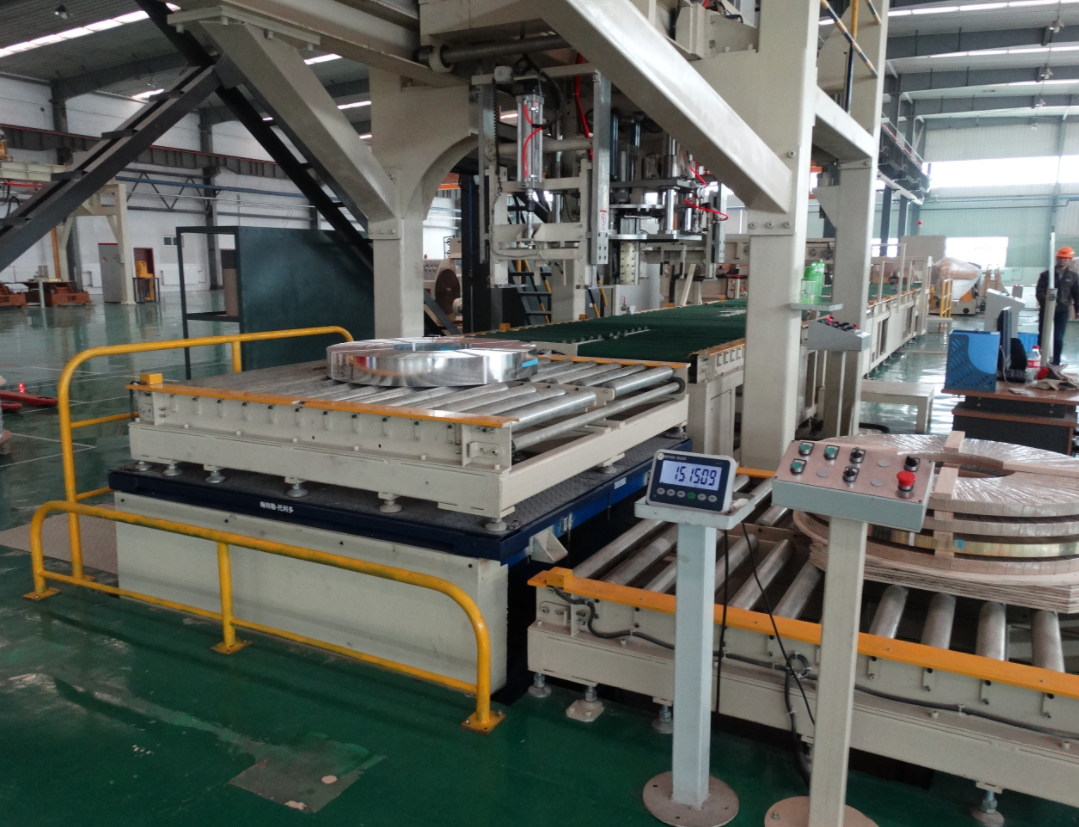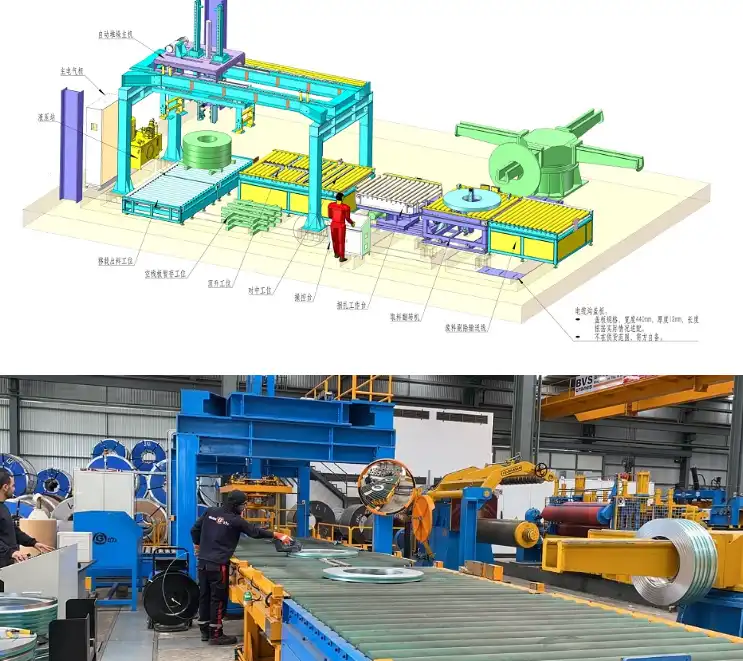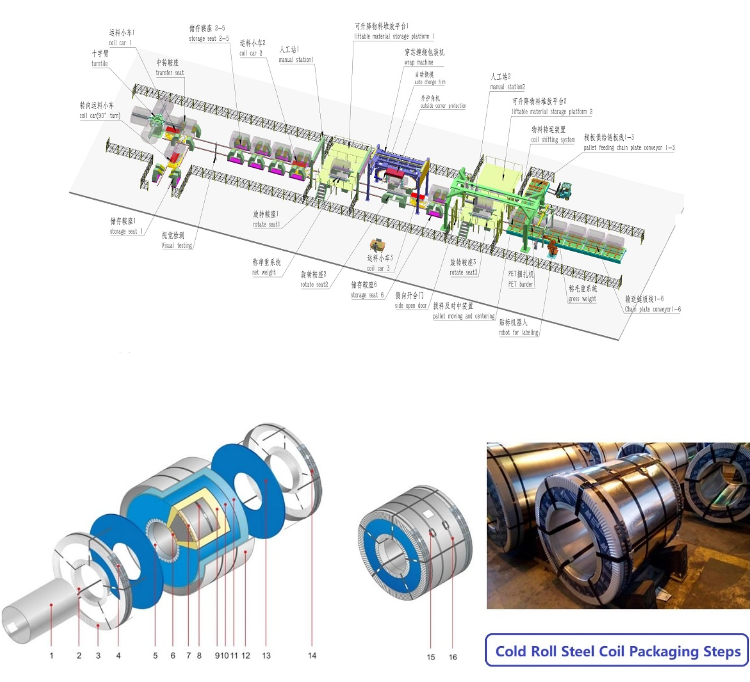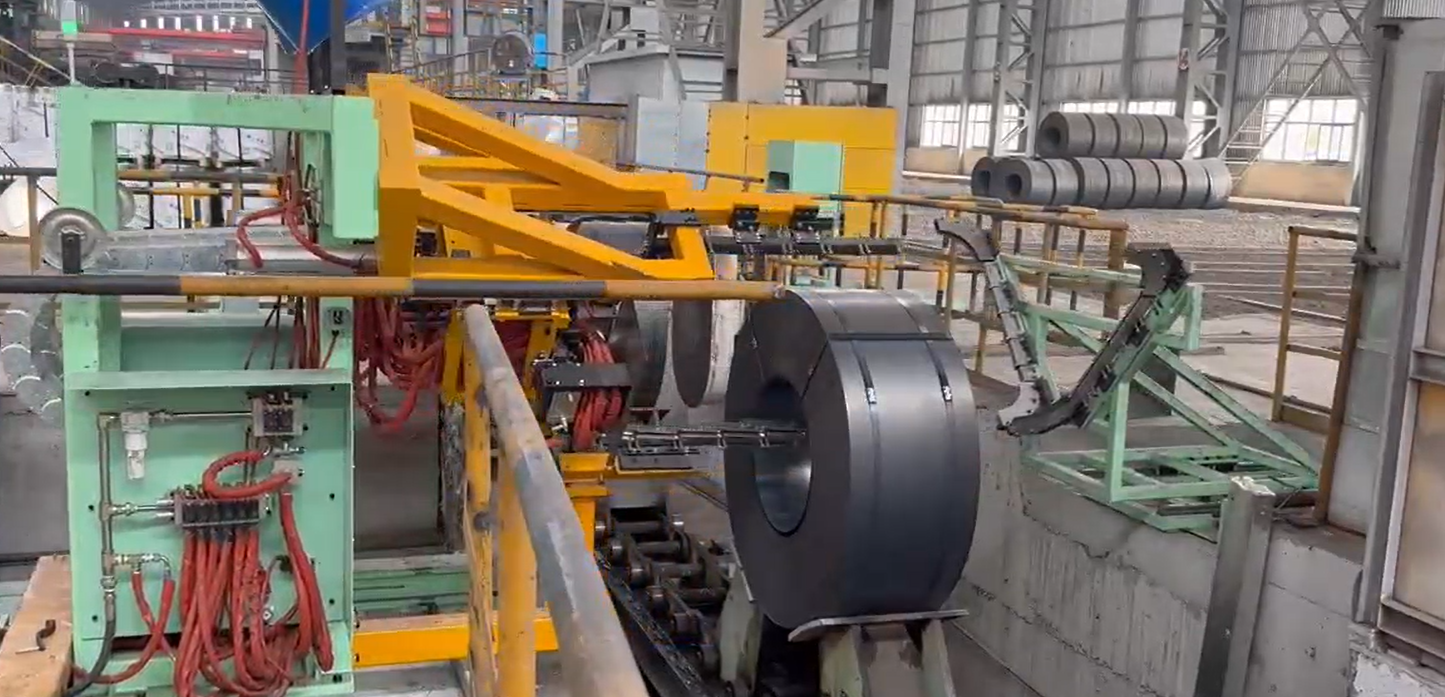As an engineer who has spent his entire career in the packaging machine industry, I’ve seen factories struggle with the same problems time and again. You invest millions in state-of-the-art production, only to have the final step—packaging—become a major bottleneck. It's a source of constant frustration, with aging equipment, rising labor costs, and inefficiencies that eat away at your hard-earned profits. This is especially true for demanding industries like steel manufacturing. The pressure to modernize is immense, but the path forward often seems unclear, leaving you stuck with legacy systems that can no longer keep up.
The solution for steel mills, particularly in dynamic Spanish-speaking markets like Mexico, is to embrace smart, automatic coil solutions. These are not just machines; they are fully integrated systems designed to communicate with your smart factory infrastructure. They use automation, robotics, and real-time data to address the core challenges of efficiency, cost, and quality control. By automating the packaging process, you transform it from a manual, error-prone cost center into a streamlined, data-rich asset that enhances your entire operation.

I understand this journey because I’ve lived it. I started as an employee on the factory floor and eventually built my own successful packaging machine company. I saw firsthand how the right technology could empower a business to grow. Now, my mission with SHJLPACK is to share that knowledge. I want to help leaders like you navigate these challenges and find the right solutions. This isn't just about selling equipment; it's about building smarter factories together. Let’s explore how to make that happen.
How can automated coil packing lines combat rising maintenance costs and equipment failure?
I often speak with factory owners who tell me their maintenance teams are constantly overwhelmed. They have key production lines with equipment that is over 15 years old. The machines break down unexpectedly, parts are difficult to find, and every hour of downtime translates into lost revenue. It feels like a never-ending cycle of putting out fires, with no time for proactive improvements. This reactive approach is not only expensive but also incredibly stressful for everyone involved.
Automated coil packing lines directly combat these issues by replacing outdated, failure-prone mechanics with modern, reliable technology. These systems are built with high-quality, standardized components and feature integrated sensors for predictive maintenance. This allows you to identify potential problems before they lead to a catastrophic failure, shifting your maintenance strategy from reactive chaos to proactive, planned control. It fundamentally changes the game, reducing both costs and stress.

The True Cost of Obsolete Equipment
When a machine that has been running for 15 or 20 years finally fails, the immediate cost of the repair is just the beginning. The real damage is often much deeper. First, there is the cost of lost production. In a steel mill, every minute the line is stopped can mean thousands of dollars in lost output. Second, there are the labor costs. Your maintenance team may need to work overtime, and operators are left idle. Third, sourcing spare parts for obsolete machinery can be a huge challenge. You might have to wait weeks for a custom-fabricated part, extending downtime even further.
I remember a client who was running an old Italian packing line. A single gearbox failed. It took them six weeks to get a replacement from Europe. During that time, they had to package all their steel coils by hand. The cost was enormous. Modern automated lines are designed using standardized components from global brands like Siemens or Allen-Bradley, which are readily available worldwide. This simple design choice can turn a six-week shutdown into a six-hour repair.
| Aspect | Old, Semi-Automatic Line | Modern, Fully Automatic Line |
|---|---|---|
| Maintenance Strategy | Reactive (Fix after failure) | Predictive (Fix before failure) |
| Downtime | Frequent and Unplanned | Minimal and Planned |
| Spare Parts | Hard to find, often obsolete | Standardized, globally available |
| Data & Diagnostics | None, relies on operator feel | Real-time sensor data, fault alerts |
| Labor for Repairs | High, requires specialized skills | Low, often simple component swaps |
Shifting to Predictive Maintenance
The most powerful feature of a modern automated line is its ability to tell you it's going to fail before it actually does. This is achieved through a network of IoT sensors that monitor critical components. These sensors track variables like motor temperature, vibration, hydraulic pressure, and cycle counts. The data is processed by the machine's PLC (Programmable Logic Controller). When a reading deviates from the normal operating range, it triggers an alert on the HMI (Human-Machine Interface). For example, if a motor starts vibrating more than usual, the system can flag it for inspection. This allows your maintenance team to schedule a check and replace a bearing during planned downtime, instead of having the motor seize up mid-production. This is the essence of achieving 95% or higher equipment uptime. It’s about using data to stay in control.
What role does smart packaging play in reducing energy consumption and meeting environmental standards?
Energy costs are a major concern for every steel mill owner I talk to, especially in regions where electricity and fuel prices are volatile. At the same time, governments are implementing stricter environmental regulations, putting pressure on factories to reduce their carbon footprint and waste. You might have already invested in major energy-saving initiatives like waste heat recovery. But many people overlook the significant energy consumption and material waste that happens at the very end of the line: in packaging.
Smart packaging systems are engineered from the ground up for efficiency. They play a direct role in reducing energy consumption and helping you meet environmental targets. This is achieved through the use of high-efficiency motors, intelligent power management systems like Variable Frequency Drives (VFDs), and precision controls that minimize material waste. An investment in smart packaging is an investment in sustainability and a healthier bottom line.

Engineering for Energy Efficiency
Older packaging machines, particularly those relying on large hydraulic power units, are notoriously inefficient. The hydraulic pump often runs continuously, even when the machine is idle between coils, consuming a significant amount of electricity. This is like leaving a car engine running at full throttle in a parking lot.
Modern automatic coil wrappers and strapping machines are different. They increasingly use servo-electric motors instead of hydraulics. These motors only consume power when they are actively performing a task, like rotating the coil or applying a strap. Furthermore, most motors on the line are controlled by VFDs. A VFD adjusts the motor’s speed to match the exact requirement of the task, rather than running at 100% speed all the time. For a conveyor, it might run slowly while waiting for a coil and then speed up to move it into position. This intelligent use of power can lead to energy savings of 30-50% for the packaging station alone. For a steel mill looking to reduce its overall unit energy consumption by 10%, optimizing the packaging line is a critical and often overlooked opportunity.
Minimizing Waste for a Greener Footprint
Environmental compliance is not just about energy; it's also about minimizing waste. Manual or semi-automatic wrapping processes are often inconsistent. One operator might use three layers of wrapping film, while another uses five. This leads to excessive material consumption. An automatic wrapping machine, on the other hand, is programmed for precision. It applies the exact number of layers with the optimal amount of stretch, every single time. This consistency can reduce your consumption of wrapping materials like stretch film or VCI paper by over 20%.
This has a dual benefit. First, it directly lowers your raw material costs. Second, it reduces your environmental impact. Less plastic film or paper used means less waste heading to the landfill and a smaller carbon footprint associated with producing and transporting those materials. Modern systems can also provide detailed reports on material consumption per coil, which is valuable data for sustainability reporting and compliance audits.
How do integrated packaging solutions support the goals of a fully digitalized smart factory?
You are building a smart factory. You're investing in a Manufacturing Execution System (MES) to get a real-time view of your production floor. You’re deploying IoT sensors to monitor your furnaces and rolling mills. Your goal is complete visibility and control, from raw materials to the finished product. But what happens when your finished steel coil reaches the end of the line? If your packaging station is a standalone "island" that doesn't communicate with your other systems, your smart factory vision is incomplete.
An integrated packaging solution is the crucial final link in your digital chain. It acts as an intelligent data node that communicates seamlessly with your MES and ERP systems. It receives instructions, executes packaging tasks automatically, and sends back vital data in real-time. This integration is what enables full product traceability, optimizes production flow, and unlocks the true potential of your digital transformation investment.

Creating a Seamless Data Flow
In a traditional factory, information at the packaging station is handled manually. A worker reads a paper order, identifies the coil, and decides how to package it. This process is slow and prone to human error. In a smart factory, this is all automated.
Here’s how it works: When a coil comes off the slitting or rolling line, its unique ID is already in your MES. As it travels to the packaging line, the MES sends a "recipe" to the packaging machine's PLC via an industrial network like Profinet or Ethernet/IP. This recipe contains all the necessary information: coil dimensions, customer specifications, required wrapping material, strapping pattern, and label information. The packaging line then executes these instructions perfectly without any human intervention. Once the coil is packaged, the line sends a confirmation message back to the MES, updating the coil's status to "packaged and ready for shipping." This two-way communication eliminates errors and creates a single source of truth for your entire operation.
| Feature | Non-Integrated Packaging | Fully Integrated Packaging |
|---|---|---|
| Data Input | Manual (Paper, operator entry) | Automatic (From MES/ERP) |
| Product Traceability | Difficult, paper-based records | Instant, fully digital history |
| Production Flow | Creates bottlenecks, manual pacing | Smooth, enables intelligent scheduling |
| System Visibility | "Information Black Hole" | Transparent node in the factory network |
| Error Potential | High (wrong packaging, wrong label) | Near-zero (automated execution) |
The Power of End-to-End Traceability
Imagine a customer calls with a quality issue on a specific coil they received. With a non-integrated system, you would have to dig through piles of paperwork to find out when it was packaged and by whom. With an integrated system, you simply enter the coil ID into your MES. Instantly, you can see its entire history: when it was cast, when it was rolled, its exact chemical composition, when it was packaged, which wrapping materials were used, and even the tension settings on the strapping machine. This level of detail is incredibly powerful for quality control, process improvement, and resolving customer claims quickly and professionally. It transforms your packaging data from a simple record into a strategic asset. This is the core of what a "smart factory" promises, and an integrated packaging line is essential to delivering on that promise.
Why is a total solution provider more valuable than just an equipment supplier for a long-term strategy?
When you need to upgrade a critical piece of your production line, you face a choice. You can find an equipment supplier who will sell you a machine, or you can find a strategic partner who will provide a total solution. A supplier focuses on the transaction; they sell you a piece of hardware. A partner, however, focuses on your outcome. They invest time to understand your long-term goals, like reducing costs by 8% or achieving 95% uptime, and they design a solution to help you get there.
For a forward-thinking leader who has built a business from the ground up, the choice is clear. A simple machine supplier creates a short-term fix, but a total solution provider becomes a long-term asset. They offer expertise that goes far beyond the hardware itself, covering everything from initial design and system integration to training and ongoing support. This partnership approach is what ensures your investment delivers the maximum possible return for years to come.

From Blueprint to a Functioning System
My company slogan is "TOTAL SOLUTION FOR WRAPPING MACHINE" for a reason. When I work with a client, the first step isn't to show them a catalog. It's to listen. I want to understand the complete picture: the factory layout, the flow of materials, the specific types of coils, the climate conditions, and the strategic goals of the business. An equipment supplier might sell the same machine to a steel mill in Mexico as they do to one in Canada. But a true partner knows that the solution must be tailored.
For example, we consider how the packaging line will integrate with your existing cranes and conveyors. We analyze the required throughput to ensure it never becomes a bottleneck for your slitting line. We discuss the best way to connect it to your MES. This initial consultation and design phase is the most critical part of the process. It ensures that the solution you get is not just a machine, but the right machine, configured for your specific operational reality. This is the difference between buying a tool and investing in a capability.
Partnership Means Long-Term Success
The relationship with a total solution provider doesn't end when the machine is delivered. That’s just the beginning. The installation and commissioning process is handled by engineers who ensure the system is physically installed correctly and digitally integrated with your network. Crucially, we focus on training your local team. For our clients in Spanish-speaking markets, we provide training and documentation in Spanish, ensuring your operators and maintenance staff are confident and competent in running and caring for the new equipment.
Years down the road, as your business evolves, a partner is still there for you. When a new environmental regulation comes out, they can advise you on how to ensure your system remains compliant. When you're ready to upgrade to the next level of automation, they can help you plan the expansion. When I started my own factory, I learned that my most valuable suppliers were the ones who acted like partners. They helped me think through problems and grow my business. This is the philosophy I’ve built SHJLPACK on. My success is tied to my clients' success.
Vincent's Insight: A Message to Visionary Leaders Like Javier
To a leader like you, Javier, who has risen through the ranks from the factory floor to the CEO’s office, I want to speak directly. We share a similar path. I also started as an employee, an engineer who loved machines. I learned the business from the inside out before starting my own factory. That journey taught me a fundamental lesson: the biggest risk in manufacturing is not the cost of investing in new technology; it's the cost of being left behind by clinging to the old way of doing things.
The challenges you face—volatile energy prices, strict environmental rules, and fierce market competition—are not temporary problems. They are the new reality. The pressure will only increase. In this environment, efficiency is not just a goal; it's a requirement for survival.
I have seen so many factories pour millions into the "front end" of their production—the furnaces, the casters, the mills. Yet, they neglect the "back end"—the final handling and packaging. This is a critical mistake. The packaging line is the last time you touch your product before it reaches your customer. It should be a showcase of your factory's quality, intelligence, and efficiency. Instead, it is often the weakest link.
Upgrading your coil packaging and handling is one of the highest-impact investments you can make. It’s not just about wrapping steel. It's about unlocking data, eliminating bottlenecks, reducing waste, and building a more resilient and profitable operation. My mission now is not simply to sell machines. It is to share the knowledge I’ve gained over a lifetime in this industry to help other passionate leaders like you succeed. Let's build the future of steel manufacturing together.
Conclusion
Investing in smart, automatic packaging is not an expense. It is a strategic move towards a more efficient, profitable, and future-proof factory. Let's start the conversation today.





